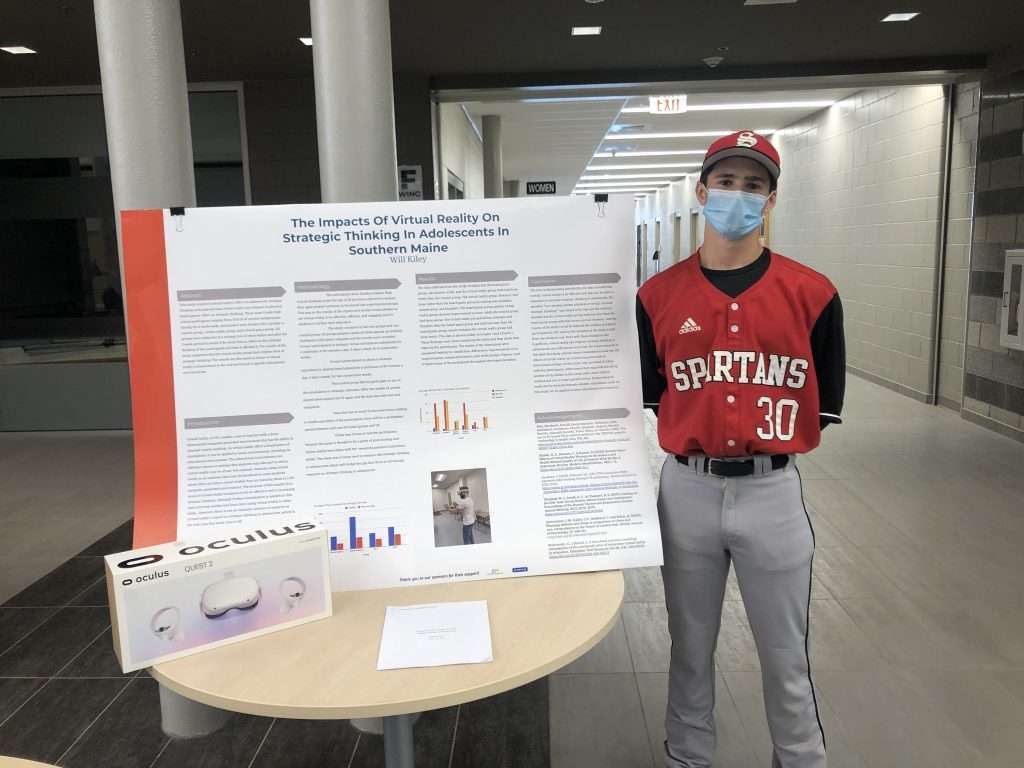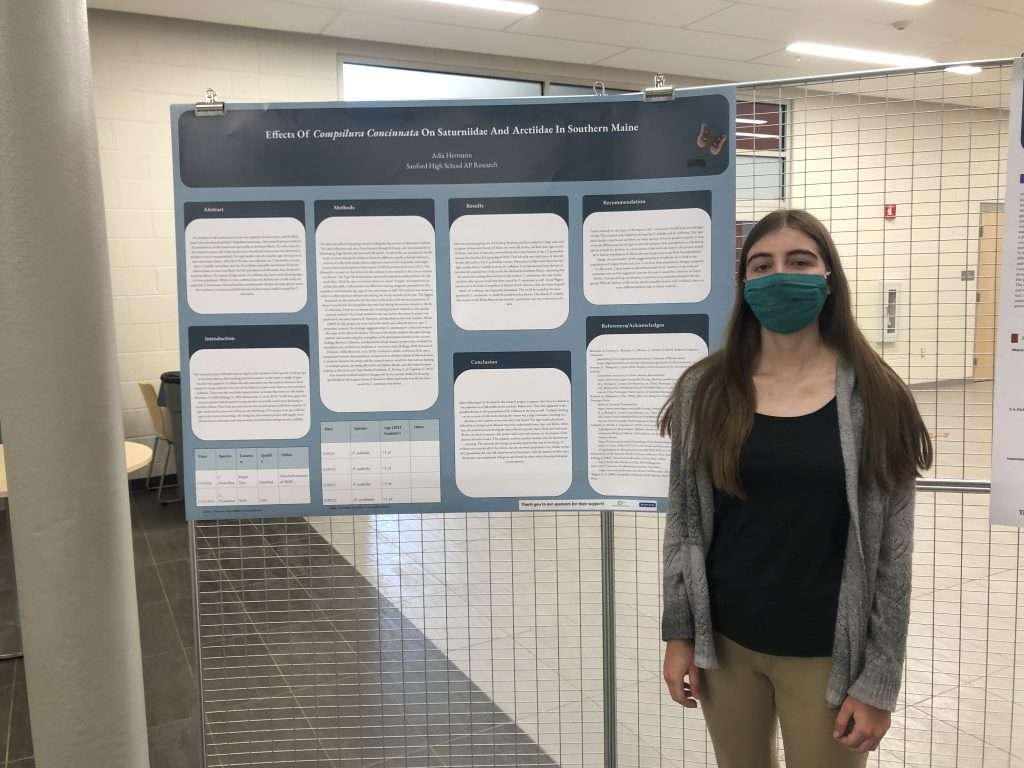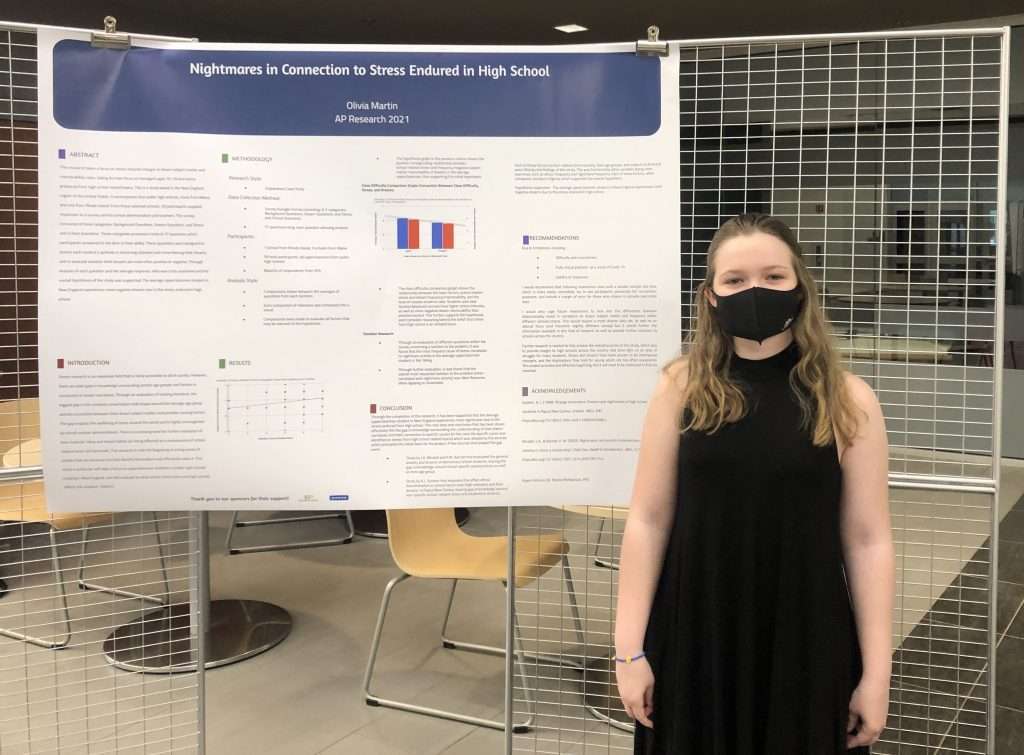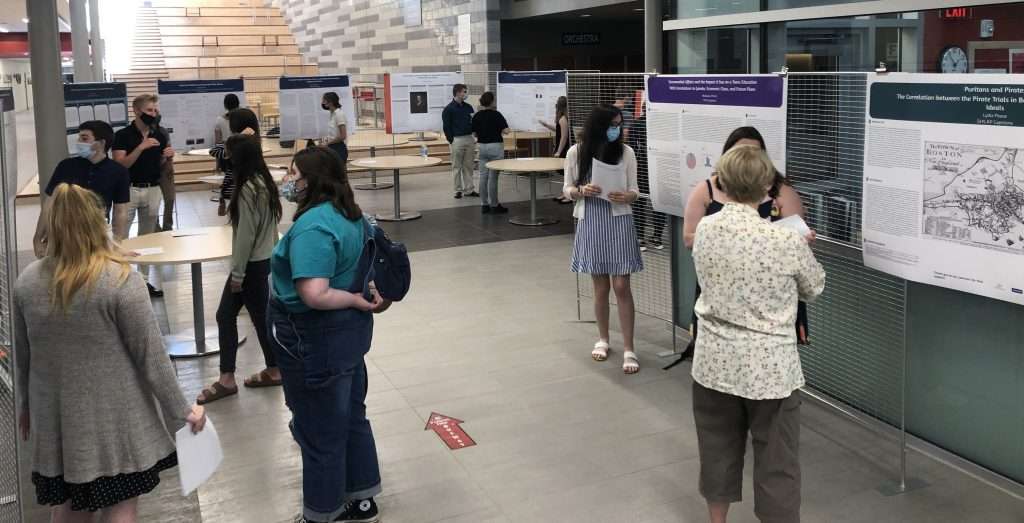SHS AP Capstone Symposium
- June 3rd 2021
- School News
- Sanford High School
Sanford High School offers many Advanced Placement or “AP” courses across several disciplines. In addition to those subject-specific courses, SHS also participates in what is called the AP Capstone program. In this program, students who choose to participate develop skills in research, analysis, evidence-based arguments, collaboration, writing, and presentation.
The culmination of each student’s original research project is a 20-minute recorded presentation, a 4000-5000 word essay, and a symposium. The symposium, which took place June 1, required students to condense their entire year-long project into one poster and present their findings to whomever walked up to their booth. The students’ presentations were professionally done and they were each able to answer questions about their projects, experiences and findings.
Adia Hermann studied Giant Silk Moths (which include Luna Moths and other species) and Tiger Moths, to try and determine if their populations are declining in southern Maine, and if that decline can be attributed to the introduction of a parasitic fly brought to this country to control Gypsy Moths and Brown-tail Moths. Adia faced some challenges in collecting her data during the winter months. She was able to find only one silk moth cocoon. Anecdotal evidence she found online suggests that they were plentiful in the past, so this appeared to confirm her hypothesis that their numbers have declined in this area. She found three hibernating Tiger Moth caterpillars but, to avoid harming them, did not cut them open to determine if they were parasitized. In addition to learning about moths, Adia said one of the most important skills she learned through the project was time management. She is considering studying biology or agriculture in the future.
Joshua Werner studied the impact of SAM-e on depression in mice. SAM-e is sold over the counter as a supplement in the US, but in Europe it is sold as a prescription antidepressant. Although SAM-e has been studied in this country, none of the studies that have been done was long enough to meet FDA criteria for consideration. Joshua’s month-long study was the first. He measured depression in the mice by their behaviors, including hostility to each other, length of time they ran on their wheels, and amount of time they slept each day. He found that after being given SAM-e for just two days, all of these behaviors improved and they interacted with each other more. Joshua said what he enjoyed most about his project was observing the experiment in real time. He hopes to study the business side of medicine in the future.
Lydia Pease studied whether Puritan religious beliefs affected the trials of two New England pirates in 1704 and 1726. To do her research, she looked at primary source documents about the trials, including a 1704 newspaper story and an account by Puritan minister Cotton Mather of the crimes, trial and execution. She counted the number of times certain words were used, including God, sin, repentance and grace, to prove her hypothesis. Lydia said the 16th century language took some getting used to. She also learned that research takes longer than expected. She plans to study history with the goal of working in a museum in the future.
Makayla O’Brien’s topic was the affect on teens’ education caused by the extramarital affairs of their parents. Her hypothesis was that it would affect the students’ grades and future plans. She surveyed 195 students for the project. The first lesson she learned was that many teens don’t know the meaning of the word “extramarital.” She also learned that a research project of this type is dependent on the people who respond. She did find a correlation, but because most of her respondents were middle class, female students with higher grades, her research can only be applied to that specific group. Maykayla hopes to study medical science in her future education.
The other students who participated in the symposium were:
- Alison Machinski: Strawberries and their Positive Impacts
- Riley LaRose: Analyzing the psychological causes behind Aaron Burr dueling and killing Alexander Hamilton
- William Kiley: The impacts of Virtual Reality on strategic thinking in adolescents in Southern Maine
- Connor Curcio: Pre-Task music’s effects on Amateur High School athletes performance in competition
- Vanessa Hlastawa: Analyzing the effect of Economic Stress on low socioeconomic Students’ outlook of the future
- Ryleigh Coffey: Industrial Herbicides and Successful plant species: an experimental design into potential causes of Chemicals
- Olivia Martin: Nightmares in connection to stress endured in high School
- Isabella Farrington: The impacts of socioeconomic factors on participation in High School Arts Education
Students who complete the two-year AP Capstone program can earn one of two different awards, which are valued by colleges across the United States and around the world. The AP Capstone Certificate is awarded to students who participate in the two year program, taking both AP Seminar and AP Research, and earning a 3 or higher on their exams for those two courses. The AP Capstone Diploma requires students to take not only those two AP Capstone courses, but also an additional 4 AP subject courses, and earn a 3 or higher on all of their exams. These two awards signify the students outstanding academic achievement and attainment of college-level academic and research skills. Sanford is one of only 2,100 schools in the world that has been accepted into the AP Capstone program.




Subscribe to our twice-weekly email newsletter and never miss a story! Visit sanfordspringvalenews.com/subscribe/ to sign up.






